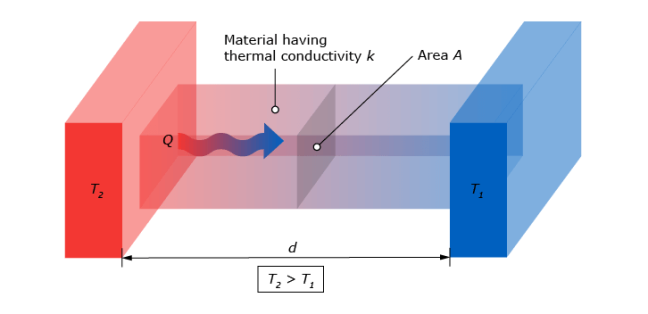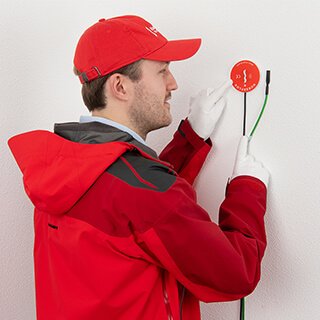Heat loss calculation: heat transfer through surfaces and convection
Heating is expensive and may affect the environment through greenhouse gas emissions, so it is important to identify the largest sources of heat loss in a building. Performing a heat loss calculation aids in making buildings more efficient by enabling effective placement of insulation.
This article provides a comprehensive guide for conducting a heat loss calculation. First, we explain what heat loss is and how it occurs. Then we clarify why and how we conduct heat loss calculations.
What is heat loss?
Heat loss occurs when a building has a higher temperature than its surroundings. The heat flows from the building to the surroundings due to the temperature difference. As a result, the temperature in the building decreases. Therefore, a comfortable living temperature often requires heating to compensate for the heat loss.
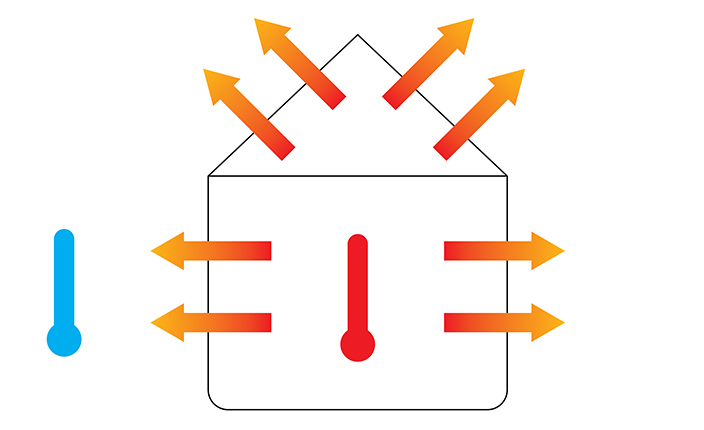
Because of this temperature difference, the building will exchange heat with the surroundings.
This is why constant heating is necessary to sustain a comfortable temperature inside the building.
The amount of heat loss depends on many factors, including but not limited to:
- Inside-outside temperature difference is the most obvious factor. Clearly, cold winter days require more heating than mild spring days to maintain the same indoor temperature.
- Building size is also important. A larger building typically has a larger envelope, which means that it has more surfaces to lose heat from and more volume to heat.
- Building age often indicates the quality of insulation. Older buildings often have more air gaps and less insulation than modern buildings.
- Building materials are crucial for thermal insulation. All building materials possess a specific thermal transmittance (U-value), which indicates how readily a material transfers heat. Insulation has a low thermal transmittance, while metals have a high thermal transmittance. Therefore, insulation serves as a way to reduce heat loss.
The mechanisms behind heat loss
Heat loss occurs via three different mechanisms: radiation, air circulation, and fabric heat loss. We will explain each mechanism and discuss its importance in total heat loss.
1. Radiation
All objects lose heat through thermal radiation. Especially hot objects emit a lot of thermal radiation, like glowing-hot metal or a light bulb. When the interior of a building is warmer than the outside, it sends out more thermal radiation than it receives from the surroundings. This results in a net heat loss. However, this mechanism mainly occurs through windows, as they transmit thermal radiation very well. Therefore, it generally plays a relatively small role in the total heat loss of a building, typically accounting for less than 10 % of the total heat loss in houses.
2. Air circulation
All buildings require some form of air ventilation for fresh air. This happens via intentional ventilation and unintentional air leakage. Both processes replace the air inside the building with fresh air from the outside. The replaced air carries a lot of heat, playing a major role in the total heat loss.
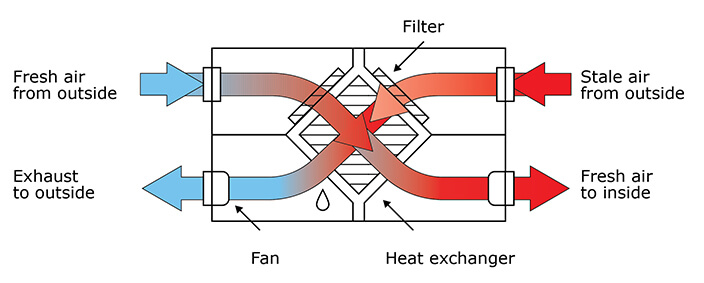
and then they pass through a heat exchanger. This is a very efficient process where a large portion
of the heat can be recovered.
Modern buildings often use heat recovery ventilation, which mitigates a significant portion of heat loss due to ventilation (up to 90 %) by transferring heat from the outgoing air to the incoming air. However, without such systems ventilation still plays a major role in the total heat loss.
Air leakage occurs mainly through door gaps, window frames, and openings in the walls. Installing weather strips and proper insulation can significantly reduce air leakage. Modern buildings are especially airtight.
3. Fabric heat loss
Fabric heat loss refers to heat transfer through the building envelope, including walls, windows and roofs. This is often the largest contributor to the total amount of heat loss. When there is a temperature difference between two sides of a solid, heat transfer through the medium will occur. Therefore, heat is lost through the building envelope when the outside temperature is lower than the interior temperature.
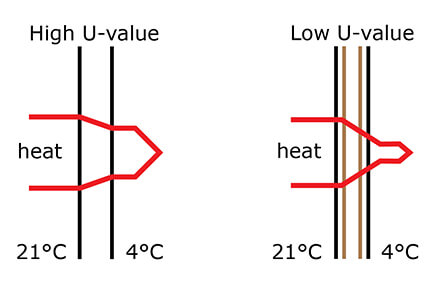
What this means, is that the heat easily passes a wall with a high U-value (left),
while less heat escapes through an insulated wall with a low U-value (right).
The thermal transmittance is an important value when discussing fabric heat loss. The thermal transmittance is the rate of heat transfer through a solid. Therefore, lowering the thermal transmittance of the building envelope is a very effective way of reducing the total heat loss. Applying insulation is a common way to decrease thermal transmittance. A wall without insulation can have a thermal transmittance up to ten times higher than a well-insulated wall.
You can read our article What is heat flux? to learn more about the different mechanisms of heat loss.
Why perform a heat loss calculation?
A heat loss calculation can provide valuable insights when looking for ways to reduce heat loss. The list below provides some examples where a heat loss calculation can be useful:
- A heat loss calculation provides insight into the current insulation quality of the building. By comparing the calculated heat loss with the measured heat loss, the quality of the insulation can be determined. Is the measured heat loss significantly higher than the calculated value? That often implies that the thermal transmittance of your insulation is higher than expected. This can occur when the insulation is poorly installed or faulty.
- It can help with identifying the most impactful insulation measures by identifying areas with large amounts of heat loss. This way, you can prioritize insulating significant heat loss sources.
- The heat loss calculation gives an indication of the amount of required heating. This estimates the heating costs over a certain period of time. Using this estimate, you can determine whether additional insulation measures will be cost-effective.
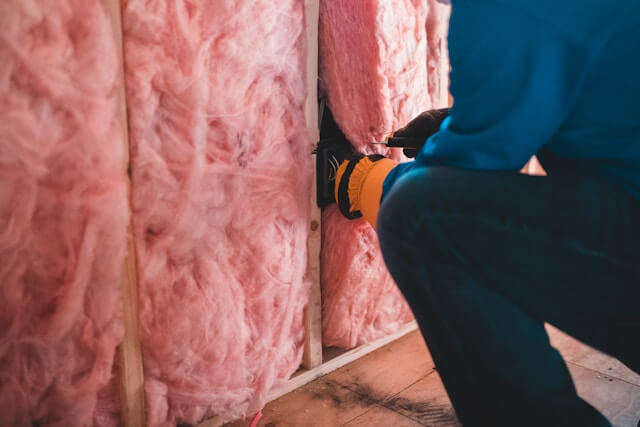
resulting in less heat loss. Therefore, insulation is an effective way to reduce total heat loss.
Photo by Erik Mclean on Unsplash.
How to perform a heat loss calculation
Before conducting a heat loss calculation, it is important to know what values we need to measure beforehand. Then, we show a step-by-step approach for the calculation. Finally, we work through an example. It is important to note that heat loss via radiation is neglected, because of its fairly small impact and relatively difficult calculations.
What measurements do you need?
To obtain a reasonable value from the heat loss calculations, it is important to accurately measure the relevant quantities. We separate the measurements into quantities relevant to air circulation and fabric heat loss.
1. Air circulation measurements
An important quantity for determining heat loss by air circulation is the air changes per hour (ACH). An ACH of 1 means that the air within a building is replaced entirely once every hour. A higher ACH means that more heat loss occurs due to circulation.
For ventilation, the airflow (Q) is often provided by the manufacturer of the installation. Therefore, the ACH by ventilation can be found by using

Where:
- Q is the specified airflow in cubic meters per hour
- V is the volume of the building in cubic meters
The circulation due to air leakage must be measured. One common way to measure it, is using a blower door test. It works by blowing air into a building until a certain pressure difference with the outside is reached. Less air is necessary to create this pressure difference for an airtight building than for a leaky building. When the desired pressure difference occurs, the blower door measures the provided airflow. Then, this measurement value determines the ACH by air leakage.
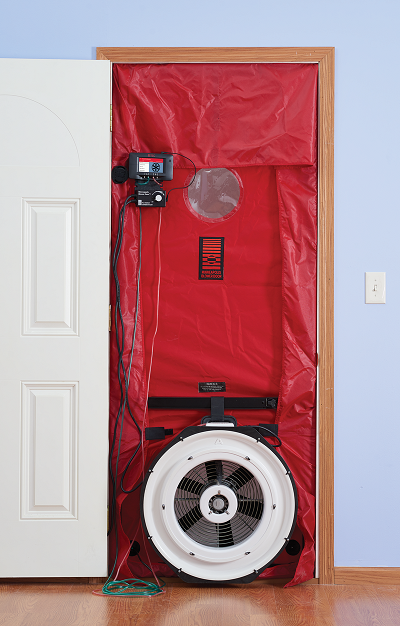
The door has a pressure meter and a fan. By relating the pressure with the
airflow provided by the fan, the air leakage can be determined.
Photo by Wikimedia.
2. Fabric heat loss measurements
The most important quantity for fabric heat loss calculation is the thermal transmittance, also known as the U-value. It is important to note that the U-value is the inverse of the thermal insulance, also known as the R-value, which is often used in North America. This means that measuring the U-value immediately results in knowing the R-value as well.


can determine the R-value and U-value with high accuracy.
This is necessary for accurate heat loss calculations,
since the U-values of common building materials can
differ greatly.
Many common building materials have typical U-values. However, in practice, these U-values can vary greatly. This is because the U-value depends on factors such as the quality of the insulation and its installation. Therefore, measuring the U-value for all relevant surfaces is important to accurately calculate the fabric heat losses of a building.
A thermal resistance measurement system, such as the TRSYS20, determines the thermal transmittance very accurately. It works by measuring the heat flux through a surface in combination with the temperature difference between the inside and the outside. The resulting measurement, accurately determines the R-value and U-value. These measurements are crucial for a reliable heat loss calculation, since the U-values vary greatly from surface to surface.
Read our article Heat transfer through a wall to see how the TRSYS20 can measure the thermal properties of a wall.
A step-by-step approach to the heat loss calculation
To calculate the total amount of heat loss, we will first calculate the heat loss due to air circulation and then calculate the fabric heat loss.
1. Calculating air circulation heat loss
The heat loss due to air circulation is proportional to the volume of the building, temperature difference with the outside, the total ACH and the thermal properties of air. We must also make a distinction between the air circulation due to ventilation and air leakage, since ventilation systems can retrieve the lost heat partially. The formula for heat loss due to air leakage is given by:

Where:
- Qleak is the rate of heat loss in W due to air leakage
- V is the volume of the building in m3
- ΔT is the inside-outside temperature difference in K
- ACHleak is the total air changes per hour due to air leakage
- ρ is the density of air in kg m-3
- C is the specific heat capacity of air in J kg-1 K-1
We use the same formula for ventilated air, but multiply it with a factor that accounts for the heat retrieval of the ventilation system:

Where:
- Qvent is the rate of heat loss in W due to ventilation
- ACHvent is the total air changes per hour due to ventilation
- β is the efficiency of the ventilation system (between 0 and 1)
The air density (ρ) and specific heat capacity (C) vary with the temperature and humidity. Fortunately, their values are well documented and can be found online. The ventilation system manufacturer provides the thermal efficiency and airflow of the ventilation. The building volume, inside-outside temperature difference, and the leakage ACH must be measured. The total air circulation heat loss is found by adding Qleak and Qvent.
2. Calculating fabric heat loss
The fabric heat loss is calculated separately for all surfaces with a different thermal transmittance. The total fabric heat loss consists of the contributions of all building surfaces. The fabric heat loss is proportional to the surface area, thermal transmittance and the inside-outside temperature difference. For a surface with a constant thermal transmittance, we use the following formula
Where:
- Q is the rate of heat loss in W
- A is the surface area in m2
- U is the thermal transmittance in W m-2 K-1
- ΔT is the inside-outside temperature difference in K
For a building with four faces, we use the formula above for each face and sum the results to get the total amount of fabric heat loss:
![]()
Where Q1 to Q4 indicate the heat fluxes of the individual surfaces.
The air circulation heat loss, together with the fabric heat loss, add up to the total heat loss. In this calculation, the heat loss due to radiation is neglected, but in general it plays a minor role in the total heat balance.
Example heat loss calculation
A facility manager wants to calculate the expected amount of heat loss in the new office building to estimate the heating costs during winter. This gives her insight into whether additional insulation measures are required. Below are all the values that we need for the calculation.
- The building is 10 meters wide, 30 meter long and 15 meters high, resulting in a volume (V) of 4500 m3.
- The office has a new ventilation unit with an efficiency (β) of 85 % which provides 2 ACH of airflow.
- The building is airtight, resulting in only 0.1 ACH due to air leakage.
- The walls are insulated and have a thermal transmittance (U) of 0.2 Wm-2K-1 and a total surface area (A) of 900 m2.
- The office has double glazed windows with a thermal transmittance of 2.2 Wm-2K-1 with a total surface area of 300 m2.
- The roof and floor have a thermal transmittance of 0.25 Wm-2K-1 and both have a surface area of 300 m2.
- The average outside air temperature during the heating season is 4 °C and the soil temperature is estimated to average 8 °C.
- To keep the employees warm and motivated, the office has an internal temperature of 21 °C. So, there is a 17 °C temperature difference (ΔT) with the outside air and a 13 °C temperature difference with the soil.
- For the calculations, an air pressure (ρ) of 1.2 kg m-3 and a specific heat capacity (C) of 1000 J kg-1K-1 is used.
We start the calculation by finding the heat loss due to air circulation. Filling in the air leakage equation gives

Filling in the air ventilation equation gives

Which gives a total heat loss due to air circulation of Qair = 10.2 kW.
For the fabric heat loss, we have to fill in the formula for all the different surfaces:
![]()
![]()
![]()
![]()
Adding the contributions of all different surfaces yields the total fabric heat loss:
![]()
![]()
Adding the fabric heat loss and the ventilation heat loss results in a total heat loss of 26.73 kW. Therefore, the heater supplies about 27 kW on average to maintain the internal temperature of 21 °C.
Conclusion
Accurate heat loss calculations are necessary for the effective placement of insulation, and determining whether insulation measures are cost-effective. Heat loss mainly occurs due to air circulation and heat transfer through surfaces of the building, known as fabric heat losses. Especially in smaller buildings - like houses - the fabric heat loss is the largest contributing factor to the loss of heat.
Measures like weather strips and heat recovery ventilation can significantly reduce the heat transfer by air circulation. Insulating walls and using double-glazed windows decreases the fabric heat loss by reducing the thermal transmittance (U-value). Although U-values of common materials are available, in practice they deviate significantly.
Therefore it is important to precisely measure the U-values of a building to enable accurate heat loss calculations. That is why a thermal transmittance measuring system, like the TRSYS20, can be a useful tool for heat loss calculations and research. The TRSYS20 provides high-quality measurements for the thermal transmittance and complies with ISO and ASTM standards.








